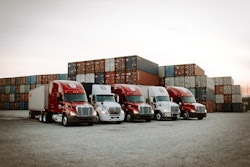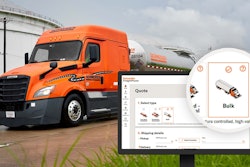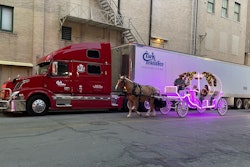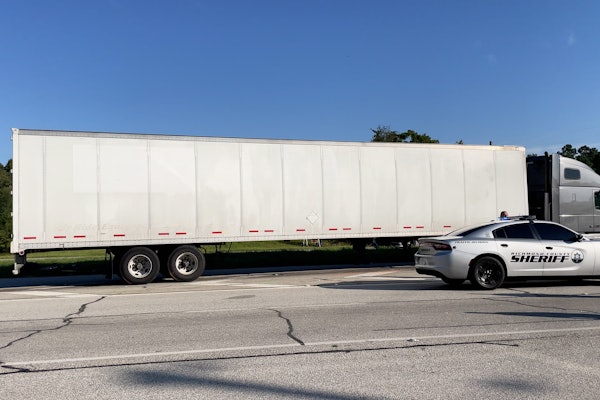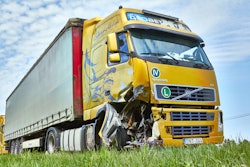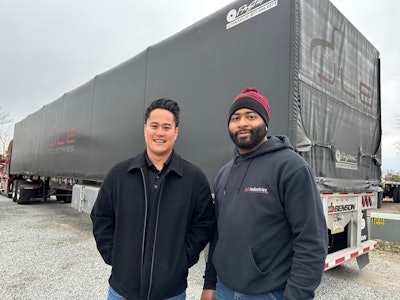
CCJ Innovators profiles carriers and fleets that have found innovative ways to overcome trucking’s challenges. If you know a carrier that has displayed innovation, contact CCJ Chief Editor Jason Cannon at [email protected] or 800-633-5953.
Truck drivers can’t read emails while rolling down the road behind the wheel of multi-ton vehicle, but that’s how Ricky Murray got his loads prior to joining Pittsburg-based JLE Industries. Often by the time he was able to read the email, he had lost out on the load.
As a driver at JLE, Murray is able to select his own loads through the company’s DriverOS app – something he likens to being a kid in a candy store getting to pick his poison.
[Related: Pittsburgh flatbedder named CCJ's 2022 Innovator of the Year]
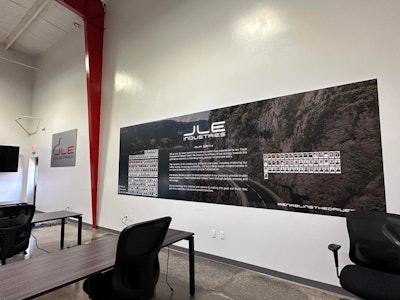 JLE highlights its "Oath Wall" that features employees, from back office to drivers, in its training facility.Angel Coker
JLE highlights its "Oath Wall" that features employees, from back office to drivers, in its training facility.Angel Coker
Murray said JLE is the only company he has worked for that allows its drivers to pick their loads, adding the DriverOS app is among the top five reasons he said he remains at JLE, calling it a tool that makes his life easier. "It’s a lot more efficient than anyone else I’ve ever dealt with," he said. It's part of JLE's commitment to "provide an elite experience for our Trade Professional Flatbed Talent through people, process and technology."
The app landed the Pittsburgh flatbed carrier CCJ's 2022 Innovator of the Year honors earlier this year.
CCJ has now recognized JLE twice for its DriverOS innovation – first in 2018 for its initial development as a means to give load planners and managers all the information and tools they needed to collaborate with drivers to maximize their productivity and earnings. JLE now, as CCJ's 2022 Innovator of the Year, is being recognized for taking its proprietary software platform to app form, allowing drivers to get involved firsthand, and it has benefitted the company on multiple levels but especially retention.
“It’s retention because the power of the pro driver is in their hands,” said JLE Chief Operating Officer Tim Tran. “People like to be in control of their destiny; a lot of other companies, they don’t give you the ability to do that stuff.”
Tran said many other trucking companies offer an app, but it simply integrates a load board, and the driver still has to do all the work, like calling the broker and calculating deadhead, among other things. He said DriverOS is more of a planning tool, where every piece of information they may need is available at the drivers’ fingertips.
All of JLE’s shipments are pulled into the app, and drivers can use the app to select their desired load, which is then approved by a fleet manager. It also shows drivers similar loads in the area when they click on one they’re interested in, giving them additional options to choose from.
JLE uses a proprietary star system that rates loads based on market conditions. For example, an $8,000 load from Alabama to Idaho may look enticing to a driver, but Tran said it would rate lower because the driver isn’t likely to find another load in the drop-off area to move somewhere else, resulting in deadhead and lowering the load’s star rating. If the rating falls below three stars, JLE doesn’t show it to its drivers at all.
“But the driver doesn’t have to calculate all that. They don’t have to search and figure out if it’s a good market,” Tran said. “Mark Zuckerberg said it best: why do they wear the same (style) shirt every single day? Because of decision fatigue. By the time you’ve made all these decisions, your mind is fatigued, so we try to limit and eliminate a lot of that stuff so they can do one thing and one thing only and that is focusing on driving.”
It also creates more back-office efficiency, Tran said, because fleet managers don’t have to calculate things manually, like whether a driver will make it to destination on time based on things like how fast they typically drive, scheduled delivery time, hours of service restrictions, distance to destination, etc.
DriverOS, which has all JLE systems integrated and updates every two to three minutes, manages it all and makes the information easily digestible. Driver managers know if something is highlighted in green, they can dismiss it because that means the load is on time; if it’s in red, the load is late; if it’s in orange, it hasn’t been dispatched. And they can make more informed decisions at a quicker rate because of the efficiency the system provides.
Creating an algorithm
 Matthew Thompson, one of JLE Industries' fleet directors, uses DriverOS to track loads drivers select in the recently created DriverOS app.Angel Coker
Matthew Thompson, one of JLE Industries' fleet directors, uses DriverOS to track loads drivers select in the recently created DriverOS app.Angel Coker
While JLE’s star system rates loads based on the market, its drivers can rate loads too, similar to the TikTok algorithm where if a user interacts with a video by liking, commenting on or sharing it, it generates related content based on those preferences.
The DriverOS app sends drivers a survey once a load is complete, and they can rate the type of freight and the shipper and receiver on things like timeliness, efficiency and facilities (if public restrooms and parking were available), among other things. The app will then suggest loads based on that feedback.
“We get all that feedback, and we bring it back to our system,” Tran said. “If John rated this load awful, saying it took forever to load, he will never see that load again.”
And it will only change John’s algorithm – not impacting other drivers.
The system also looks at drivers’ habits – like average speed they travel, for instance – based on data from the TMS, ELDs and telematics to recommend loads.
In the app, drivers can input details like how much money they want to make in a given week or on an annual basis, how much home time they want, number of miles they want to drive, type of freight they want to haul, etc., and DriverOS recommends loads based on that data, too.
Tran said it’s about treating each driver individually and treating them like the professionals they are, not micromanaging them.
“The system digests a ton of information to determine the best loads to recommend based on each individual driver. It’s a more fluid way,” he said. “We can recommend loads to them; there is no forced dispatch. They have autonomy over what they do.”
Watching the benefits pour in
That autonomy has led to an increase in recruitment and retention.
Murray said when he shows other drivers the DriverOS app, it gets them excited to apply with JLE because they like the idea of being able to pick their own loads. Each driver has a QR code in their app that allows their referrals to scan it and go directly to a JLE application, and a recruiter contacts that applicant within the first five minutes of receiving their application, Tran said. He said that response time is a huge factor in the recruitment process.
“The best part is drivers show it when they’re out at truck stops; that’s how we recruit; they show and display DriverOS,” Tran said.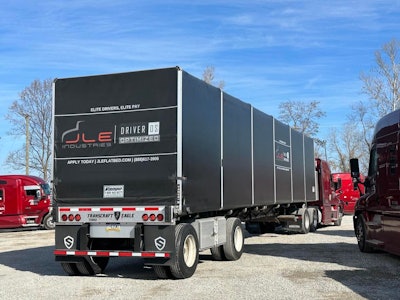 JLE advertises its DriverOS app on the road with this conestoga.Angel Coker
JLE advertises its DriverOS app on the road with this conestoga.Angel Coker
He said the drivers enjoy it and are confident using it because of its ease of use. Murray, who helped in the development of the app by piloting its features and providing feedback, said it’s intuitive.
Tran said word of mouth is the top recruiting avenue for JLE, so it’s important to ensure its drivers are happy so they will make referrals, and the app helps with that too. A big part of that is the feedback loop, Tran said.
Drivers are able to make suggestions and the system counts the number of times a topic is addressed in feedback. If enough drivers comment on the same thing, JLE will test those suggestions and possibly roll them out.
But the app hasn’t carried retention on its back.
“Do I want to say it’s all the app? No. But did it help? Yes,” Tran said. “It helped with our improvement of retention over time.”
He said turnover has continued to decrease since the app was released in April 2021. In August 2020, JLE had a 150% long-term turnover rate. As of August 2022, that long-term rate had dropped to 45%, and the short-term rate was 25%. The company has 320 drivers – 70% being lease-purchase – and is looking to double that amount as well as add more to its more than 400 power units.
Tran said the app has also helped decrease deadhead and increase revenue, although that has changed with shifts in the economy.
“It helps because it suggests better situations,” he said.
The power of suggestion
Speaking of suggestions, Murray said he would suggest the addition of a search bar in the app, but added DriverOS and the app have improved significantly from their initial release.
“It’s a whole lot better now,” he said.
That’s because they are constantly updating the system, Tran said, agreeing that the first iteration of the system was awful. But through trial and error, JLE was able to discover what worked to improve the business and what didn’t.
“Structurally, on the development side in our roadmap, how that’s developed is where the business is lacking and where tech can help,” Tran said.
The company is now in its third iteration of DriverOS.
Last year, Tran said JLE focused on the planning and operations side, creating an internal marketplace for individual drivers to be able to pick shipments on their own. That side is working well now, so he said the company has moved on to safety and maintenance.
Tran said when JLE looked to the market for safety products, most of what they found didn’t offer what the company needed exactly, so they’re building their own within DriverOS.
“We’ve been really focusing on our safety modules, brining everything in one place: ELD, FMCSA data, etc.,” he said.
He said JLE is focusing on the maintenance side too, because where it once took five to six days to get a truck back on the road after a breakdown, it now takes 14-plus because of labor and parts shortages.
He said the maintenance aspect is still in the beginning stages because the focus remains on safety, but maintenance features will be a bigger focus next year.
He said they’re also looking at adding onboarding features to the app, like performing driver candidate assessments ahead of bringing them on to get a peek into their driving habits.
Right now, candidates have a “sandbox” they can play in that allows them to dive into the app and training videos ahead of onboarding. Candidates are given different scenarios to see how they react, and the DriverOS algorithm helps JLE dictate how the driver will perform, what types of loads/lanes they want and more.
“We want to understand them on a better level, so JLE is building an assessment where the candidate can plan their driving schedules for the week,” Tran said. “By the time you get to the door, I know exactly what lanes you like to run; I know exactly when you want to be home; I know what you said on your application is what you’re willing to do because what people say and what they’re willing to do are two different things so we try to button all that up.”
Other features will be added in the future, he said, potentially a module that helps drivers with their taxes, for example.
“It’s about always enhancing their experience,” he said.
Ever-evolving features
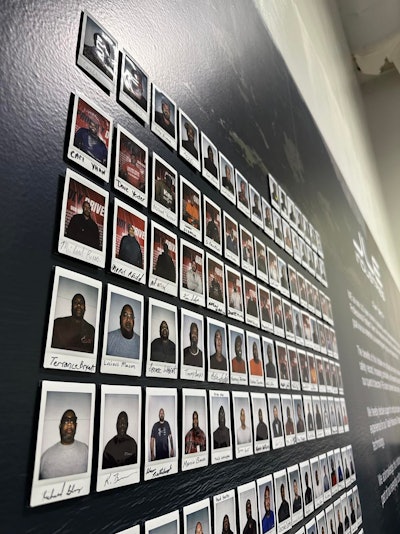 Pictured are some of JLE's drivers and other employees who have taken the JLE pledge.Angel Coker
Pictured are some of JLE's drivers and other employees who have taken the JLE pledge.Angel Coker
The feature is a rewards program that gives drivers coins for achieving different goals, like arriving at a location on time, for example. Drivers can cash out those coins for money or even donate the monetary value to a charity of their choice.
Another recent addition is uploading driver documents, like insurance cards, into the app and also allowing drivers to upload pictures of equipment.
The company has also made it easier for drivers to transition from company driver to a lease-purchase by making the application available on the app.
Tran said it gives drivers a breakdown of their finances, comparing what they make as a company driver to what they would earn as a lease-purchase driver. It also pulls the same data used in the algorithm to suggest loads to provide further guidance on their personal abilities to operate as lease-purchase. Drivers can also sift through inventory on the app that shows photos and statistics on equipment and allows them to pick what equipment they want to lease.
“It breaks it all out for them so they can make the best decision,” Tran said.
It speeds up the process and makes it easier for back-office staff as well.
In addition, Tran said JLE is currently building a new feature in the app that shows drivers on their GPS the location, distance and cost of fuel at truck stops. He said that feature will roll out by the end of the year.
Otherwise, any additional updates to the app are internal processes to better streamline things.
The CCJ Innovators program is brought to you by Comdata, Freightliner Trucks, Omnitracs and Valvoline.



